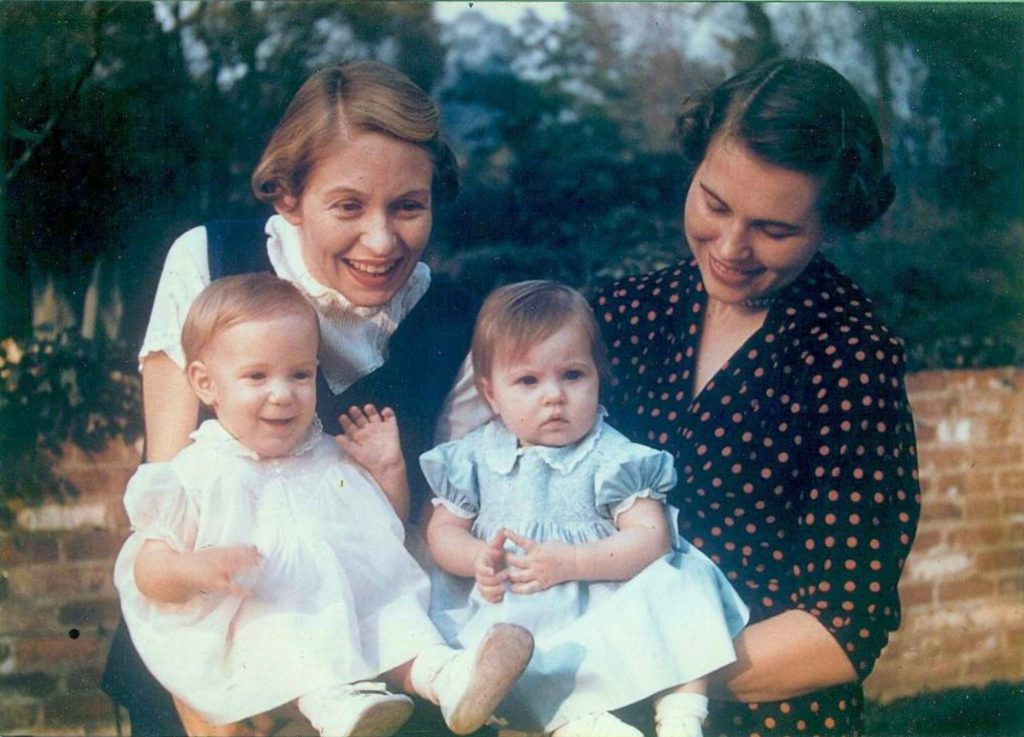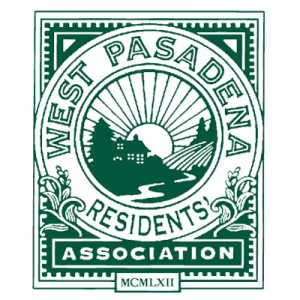1958 to 1962
by Sarah Weller King

When Marge Weller picked up the Pasadena Star-News in her driveway at 200 South Grand in Pasadena on a fall afternoon in 1958, one article jumped out at her. It was an announcement that the Vista Del Arroyo Hotel, a property that had been turned into a hospital during World War II, was to be converted into an Army induction center serving the region from San Luis Obispo south to the Mexican border and east to Arizona.
She looked up from her driveway, across the street from the old hotel, and visions of large busloads of new recruits, military vehicles and service trucks coming and going filled her with dread and anger. Where would they park? Would the traffic threaten the safety of the many children in the area? This heavy-handed intrusion by the Army would certainly doom the beautiful old neighborhood where she and dozens of others had chosen to start and raise their families.
A MOTHER OF FOUR CHILDREN under the age of 7, Marge also had a degree in political science from UC Berkeley. Originally from San Jose, she had come to Pasadena after marrying a Pasadena native, Stevens Weller Jr. After seeing the article, she went to City Hall to protest and was told there was nothing to be done about it; “the Federal Government” was in charge of the project. Her reaction to this was “Wait a minute … WE are the Federal Government. WE should be able to do something about this!”
She called her friend and neighbor, Becky Wheeler, who had also graduated from UC Berkeley and who had three young children of her own. They started calling other friends and neighbors and quickly recruited Kay Files, Virginia Blankenhorn and Cindy Adams.
As word of the Army’s plan and its detrimental impact on the neighborhood became known, the group coalesced and grew. Petitions were circulated, asking the US Congress to reverse the Army’s decision.
TODAY, 65 YEARS LATER, it is unthinkable that the government could drop something as large and disruptive as an induction center on a quiet neighborhood without any sort of due process; but that was not the case in 1958. The idea that the neighbors should rise up and fight it was new.
“We weren’t even a real group at that point,” Marge remembers. “We were just a bunch of angry neighbors who wanted to be heard. We needed to stop the Army from ruining the neighborhood.”
They continued to collect signatures. One of the neighbors, John Pike, had a brother, Tom Pike, who was an Assistant Secretary to the Navy. He may have been able to help get the message delivered to the right places.
“I’ll never know what actually happened inside the Pentagon to bring the Army’s gears to a halt,” says Marge. “What I remember clearly is the headline in the Star-News in July 1959 that said ‘ARMY DEFEATED.’”
She heard later that their Congressman, H. Allen Smith, had said to the Pentagon, “Get those @#% ladies off my back!”
IT WAS A SWEET VICTORY that had fostered friendships and encouraged the group to stay together and call themselves the West Pasadena Residents’ Association.
“The great thing about the group was that it was non-partisan,” Marge continues. “I was a republican, Becky was a democrat, and our purpose of maintaining the unique quality of West Pasadena was an example of how local issues can bring those with differing political views together. We had people who would have never befriended each other working happily together and respecting each other.”
In fact, later on Marge would be kicked off the local republican committee for having taught democrats how to work precincts so well. Some democrats took heat from their end for their willingness to work with republicans.
THE WPRA ELECTED STEVE WELLER to serve as its first informal president, collected dues and signed up hundreds of members. The next big challenge came in 1960 when the City Planning Commission was to approve a zoning variance for the construction of two 14-story high-rise buildings on Orange Grove Boulevard, near Colorado Boulevard.
Becky Wheeler recalls a conversation she had with Lee Hines, Planning Commission chair. Becky asked her why they were doing this to the neighborhood. Lee replied that it was because the neighborhood was blighted, the houses were over 30 years old and the streets were too narrow.
It was this, as much as anything, that drove the neighbors’ reaction against it. “We rose in wrath, and the rest is history,” she says.
At a public hearing on the high-rise issue, it became clear that the variance was a fait accompli, and the City was prepared to approve it.
Also attending the hearing was a Pasadena newcomer, Richard Jencks, an attorney working in the film industry negotiating labor agreements. He argued eloquently against granting the variance.
MARGE AND BECKY RECOGNIZED political talent when they saw it, and approached Jencks after the meeting to enlist him in their campaign. For a while it looked as if their efforts would fail; the City Board had approved the variance.
During a tennis match between Jencks and his friend, Roy Tolles, at Caltech, Tolles suggested that Jencks contact lawyer Tom LeSage to see whether the issue could be taken to referendum and defeated by a vote of the people. It could.
The WPRA swung into action. Marge and Becky organized precincts and assigned members to walk them city-wide.
The group started raising money for the fight — enough to print and mail leaflets and hire consultant Stu Spencer, one of the nation’ s earliest and most successful election advisors, to help organize. Richard Jencks continued to speak publicly against the variance and rally support from the Pasadena Star-News and other press outlets, proving to be an articulate and effective public spokesman.
THE WPRA HAD SOME of the best-trained and most sophisticated precinct workers in any municipal election anywhere in the country. They joined forces with other neighborhood associations, as far as Hastings Ranch in East Pasadena. “Vote YES for NO on High Rise” became a city-wide campaign. They worked hard to frame the issue as a positive vote. “We wanted people to vote yes, to be for us and with us,” says Marge. “Hence, the YES on NO phrasing.”
On November 14, 1961, WPRA’s campaign won a huge victory. The high-rise ordinance was nullified, and although the developers still pressed for their variance from the City Board, they were turned down.
BECKY REMEMBERS, “The high-rise campaign was the last straw as we saw it. After that we knew we had to have a permanent organization so we wouldn’t have to regroup again and again, because we knew there were going to be more issues that would need to be addressed.”
The group incorporated in 1962 with Richard Jencks as its first president, and officially continued with a mission of maintaining the character and enhancing quality of life in west Pasadena.
At the same time, they also realized they needed permanent elected representation with the City to help protect residential interests of the neighborhood. They chose Richard Jencks, and worked together, democrat and republican, to get him elected to the Pasadena City Board in March 1963, giving the group an official voice in policy decisions.
SINCE ITS CREATION, the WPRA has done an exemplary job of maintaining the unique quality of life and character of the neighborhood. The 50th anniversary for a group that continues to thrive is a most gratifying testament to all people, past and present, who have committed to its mission.
